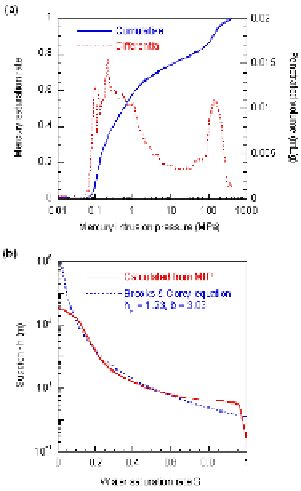Environmental Engineering Reference
In-Depth Information
9.2.4.2
. Retention curve estimation and significance
Determining the whole water retention curve requires great experimental effort.
This explains why so few data of this type on stone can be found in the literature
7
.
To solve this problem, it is therefore worth trying to estimate the retention curve
rather than measuring it.
To estimate the retention curve, one possible method [CHE 99, LAU 96b, LAU
98] consists of using the stone pore diameter spectrum obtained by mercury
intrusion porosimetry (MIP), taking advantage of the full analogy that clearly exists
between the intrusion of a non-wetting fluid like mercury and the intrusion of
another non-wetting fluid (air) during a drainage experiment. Actually, taking into
account the ratio between the surface tensions of these two fluids, mercury pressure
expressed in bars is roughly equivalent to half the water suction in meters. This is
how the suction curve in Figure 9.6b was obtained from a MIP pore diameter
spectrum. It should be pointed out that with this approach only the main
drainage
retention curve is obtained.
Figure 9.6.
Example of the estimation of the retention curve for a “Tuffeau” sample (porosity
≈
50%) from mercury intrusion data: (a) mercury intrusion test results;
(b) corresponding estimated retention curve [LAU 96b]
7 Suction curves for sandstones can be found in [HAM 93], numerous sorption isotherms on
“Tuffeau” samples are given in [DES 95] and some for marbles and granites in [CHA 98].


